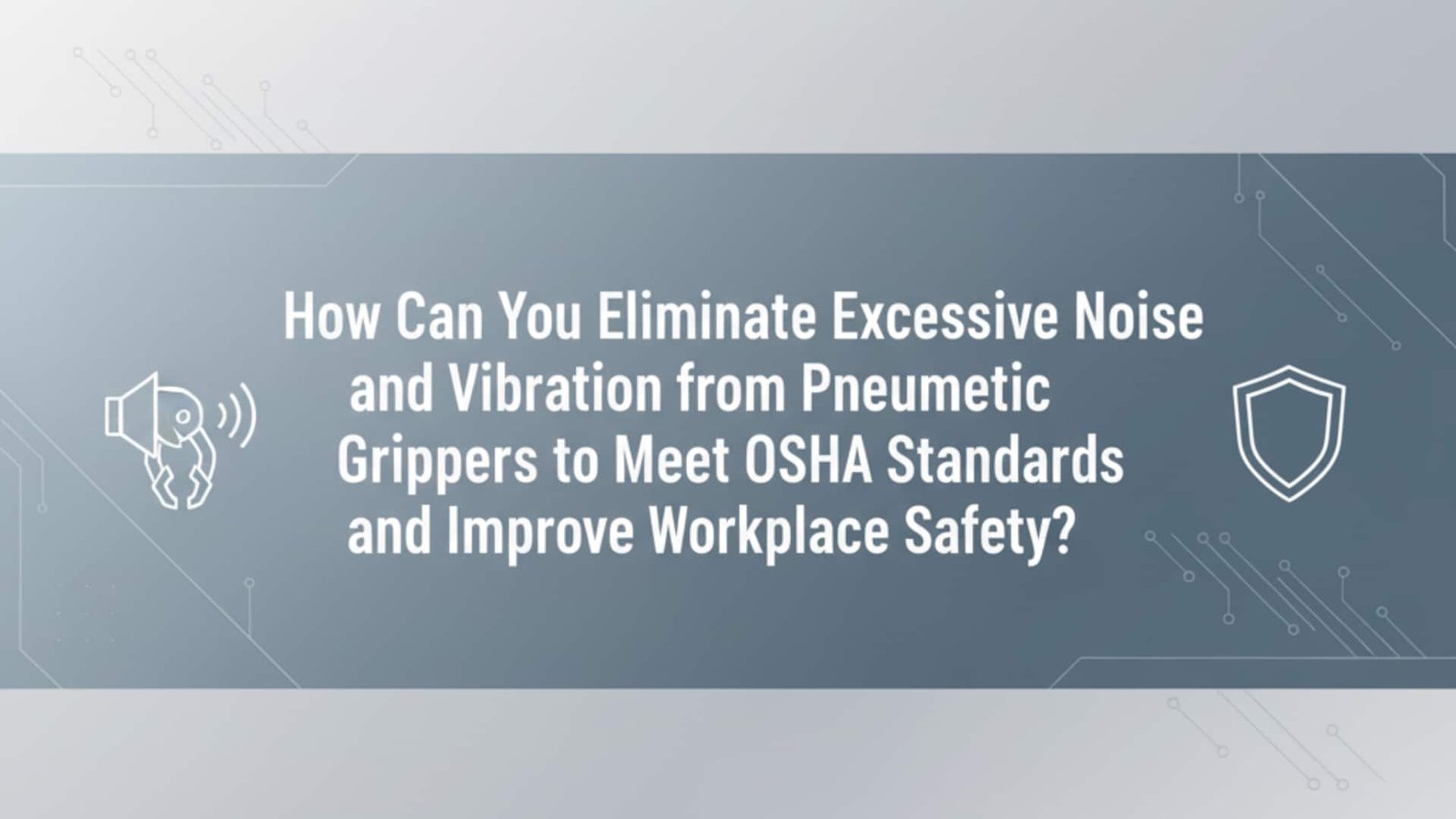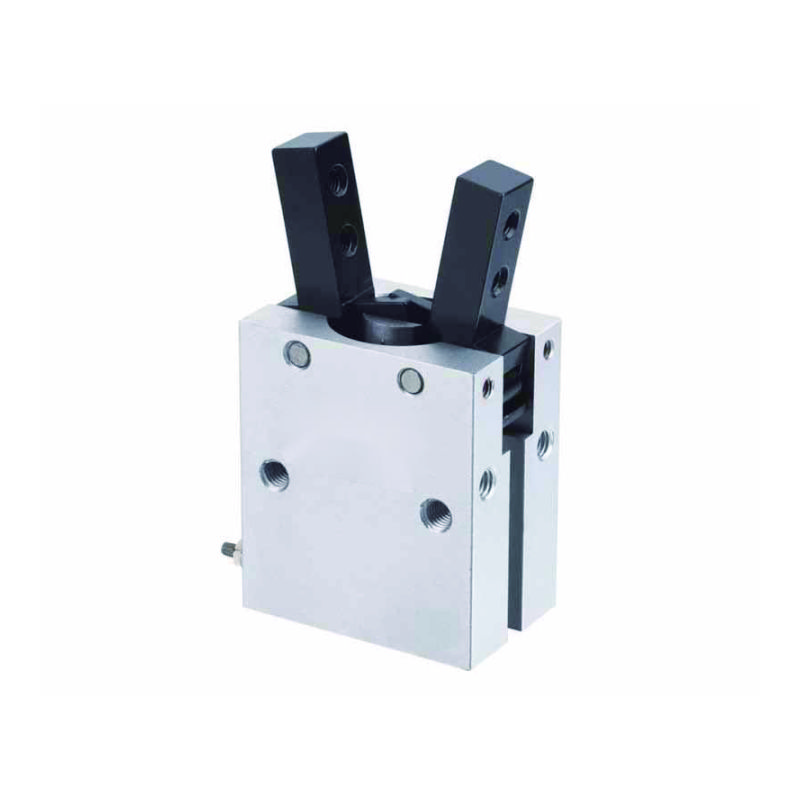Excessive pneumatic gripper noise costs manufacturers $2.3 billion annually through OSHA violations, worker compensation claims, and productivity losses from hearing protection requirements. When standard grippers operate at 85+ dB1 levels with high-frequency vibrations, they create unsafe working conditions that can lead to permanent hearing damage, reduce worker concentration, and trigger costly regulatory compliance issues that shut down production lines.
Pneumatic gripper noise reduction requires multi-stage approaches including flow control valves to eliminate air rush noise, vibration dampening mounts that isolate mechanical transmission, sound enclosures with acoustic foam rated for 20+ dB reduction, low-noise valve technology with integrated silencers, and optimized operating pressures (typically 4-5 bar vs. 6+ bar) to achieve OSHA-compliant noise levels below 85 dB while maintaining gripping force and cycle speed.
As sales director at Bepto Pneumatics, I regularly help manufacturers solve noise pollution problems in their facilities. Just two months ago, I worked with David, a production manager at an automotive parts facility in Detroit, whose pneumatic grippers were generating 92 dB noise levels that violated OSHA standards2 and required expensive hearing protection programs. After implementing our low-noise gripper solutions with integrated dampening, his facility achieved 78 dB operation – well below OSHA limits – while actually improving cycle times by 12%. 🔇
Table of Contents
- What Are the Primary Sources of Noise and Vibration in Pneumatic Grippers?
- Which Engineering Solutions Effectively Reduce Acoustic and Vibrational Energy?
- How Do You Implement Noise Control Without Compromising Gripper Performance?
- What Maintenance and Operational Practices Minimize Long-Term Noise Issues?
What Are the Primary Sources of Noise and Vibration in Pneumatic Grippers?
Understanding noise generation mechanisms enables targeted solutions that address root causes rather than symptoms.
Pneumatic gripper noise sources include high-velocity air exhaust creating 80-95 dB turbulence noise, mechanical impact from jaw closing generating 75-90 dB impulse sounds, valve switching producing 70-85 dB clicking and hissing, structural vibration transmission through mounting points amplifying noise by 10-15 dB, and resonance frequencies3 in gripper housings that create harmonic amplification at specific operating speeds.

Pneumatic Noise Sources
Air Exhaust Turbulence
- Velocity-related noise: Proportional to air speed squared
- Frequency range: 1-8 kHz, most annoying to human hearing
- Pressure dependency: Higher pressure = exponentially more noise
- Flow characteristics: Turbulent flow creates broadband noise
Valve Operation Noise
- Switching sounds: Solenoid activation and spool movement
- Air rush: Sudden pressure changes create acoustic spikes
- Cavitation: Low-pressure areas generate high-frequency noise
- Resonance: Valve chambers can amplify specific frequencies
Mechanical Vibration Sources
Impact and Contact Forces
- Jaw closing impact: Sudden deceleration creates shock waves
- Part contact: Gripper-to-workpiece collision noise
- End-of-stroke impact: Cylinder reaching mechanical stops
- Backlash: Loose mechanical connections create rattling
Structural Transmission
- Mounting vibration: Energy transfer through rigid connections
- Frame resonance: Machine structure amplifies gripper vibration
- Harmonic frequencies: Operating speed matches natural frequencies
- Coupling effects: Multiple grippers create interference patterns
| Noise Source | Typical dB Level | Frequency Range | Primary Cause |
|---|---|---|---|
| Air exhaust | 80-95 dB | 1-8 kHz | High-velocity turbulence |
| Valve switching | 70-85 dB | 0.5-3 kHz | Pressure transients |
| Mechanical impact | 75-90 dB | 0.1-2 kHz | Sudden deceleration |
| Structural vibration | +10-15 dB | 20-500 Hz | Resonance amplification |
I recently diagnosed a noise problem for Lisa, a plant engineer at a packaging facility in Ohio. Her grippers were operating at 6.5 bar pressure, creating excessive exhaust noise. By reducing pressure to 4.5 bar and adding flow controls, we cut noise levels by 18 dB while maintaining full gripping force. 📊
Which Engineering Solutions Effectively Reduce Acoustic and Vibrational Energy?
Systematic engineering approaches target specific noise sources with proven acoustic and vibration control technologies.
Effective noise reduction solutions include pneumatic silencers with sintered bronze4 elements achieving 15-25 dB reduction, flow control valves that eliminate air rush by controlling exhaust velocity, vibration isolation mounts using elastomeric materials to break transmission paths, acoustic enclosures with sound-absorbing materials rated for industrial environments, and low-noise valve technology with integrated dampening chambers that reduce switching noise by 10-20 dB.
Pneumatic Noise Control
Exhaust Silencing Systems
- Sintered bronze silencers: 15-25 dB reduction, cleanable
- Multi-stage expansion: Gradual pressure reduction
- Resonator chambers: Target specific frequency ranges
- Flow diffusers: Convert turbulent to laminar flow
Flow Control Integration
- Speed controllers: Regulate exhaust flow velocity
- Needle valves: Fine-tune flow characteristics
- Quick exhaust valves: Reduce back-pressure noise
- Pressure regulators: Optimize operating pressure
Vibration Isolation Technologies
Mounting Solutions
- Elastomeric isolators: Natural rubber or synthetic materials
- Spring isolators: Metal springs for heavy loads
- Air mounts: Pneumatic isolation for sensitive applications
- Composite mounts: Combine multiple dampening mechanisms
Structural Modifications
- Mass dampening: Add weight to reduce resonance
- Stiffness tuning: Modify natural frequencies
- Constrained layer dampening: Viscoelastic materials
- Dynamic absorbers: Tuned mass dampeners
Acoustic Enclosure Design
Sound Absorption Materials
- Acoustic foam: Open-cell polyurethane, 20-30 dB reduction
- Fiberglass panels: High-frequency absorption
- Mass-loaded vinyl: Low-frequency barrier material
- Composite systems: Multiple layers for broadband control
Enclosure Configuration
- Partial enclosures: Protect operator areas
- Full enclosures: Maximum noise reduction
- Ventilation integration: Maintain cooling airflow
- Access panels: Enable maintenance and operation
| Solution Type | Noise Reduction | Cost Factor | Implementation Complexity |
|---|---|---|---|
| Pneumatic silencers | 15-25 dB | Low | Simple retrofit |
| Flow controls | 8-15 dB | Low | Moderate setup |
| Vibration mounts | 10-20 dB | Medium | Moderate installation |
| Acoustic enclosures | 20-35 dB | High | Complex integration |
| Low-noise valves | 10-20 dB | Medium | Component replacement |
Our Bepto low-noise gripper systems integrate multiple technologies to achieve industry-leading quiet operation without performance compromise. 🔧
Advanced Noise Control Technologies
Active Noise Control
- Phase cancellation: Electronic noise cancellation
- Adaptive systems: Real-time frequency adjustment
- Sensor feedback: Monitor and adjust automatically
- Targeted frequencies: Address specific problem ranges
Smart Valve Technology
- Variable flow control: Optimize for each application
- Soft-start/stop: Gradual pressure changes
- Integrated silencing: Built-in noise reduction
- Digital control: Precise timing and flow management
How Do You Implement Noise Control Without Compromising Gripper Performance?
Balancing noise reduction with operational requirements ensures quiet operation while maintaining speed, force, and reliability.
Performance-preserving noise control requires optimized pressure settings that maintain gripping force while reducing noise (typically 4-5 bar vs. 6+ bar), flow control tuning that balances speed with acoustic output, selective dampening that isolates vibration without affecting response time, and smart timing controls that minimize unnecessary air consumption and noise generation during idle periods.
Pressure Optimization Strategies
Force-Pressure Analysis
- Minimum required force: Calculate actual gripping needs
- Safety factors: 2:1 typical for most applications
- Pressure reduction benefits: Exponential noise decrease
- Force compensation: Larger bore sizes if needed
Dynamic Pressure Control
- Variable pressure: High for gripping, low for positioning
- Sequence optimization: Minimize high-pressure duration
- Pressure sensing: Feedback-controlled gripping force
- Energy efficiency: Reduce compressed air consumption
Speed Control Integration
Flow Management
- Acceleration control: Gradual speed increases
- Deceleration dampening: Soft landing at end positions
- Velocity profiling: Optimize speed vs. noise curves
- Bypass valves: Quick action when needed
Timing Optimization
- Dwell time reduction: Minimize holding pressure duration
- Cycle synchronization: Coordinate multiple grippers
- Idle pressure: Reduce pressure during standby
- Quick release: Fast part release without noise spikes
Performance Monitoring
Key Performance Indicators
- Cycle time: Maintain or improve speed
- Gripping force: Verify adequate holding power
- Positioning accuracy: Ensure precise placement
- Reliability metrics: Track failure rates and maintenance
I helped Robert, a manufacturing engineer at an electronics assembly plant in California, implement noise control that actually improved his gripper performance. By optimizing pressure and adding flow controls, we reduced noise by 22 dB while increasing cycle speed by 8% through better control dynamics. ⚡
What Maintenance and Operational Practices Minimize Long-Term Noise Issues?
Proactive maintenance and operational protocols prevent noise escalation while maintaining optimal gripper performance over time.
Long-term noise control requires regular silencer cleaning and replacement every 3-6 months, lubrication of moving parts to prevent wear-induced noise, air system maintenance including filter replacement and moisture removal, vibration mount inspection for degradation or loosening, and operational training to prevent abuse that increases noise levels through improper pressure settings or excessive cycling.
Preventive Maintenance Protocols
Silencer Maintenance
- Cleaning frequency: Every 3-6 months depending on environment
- Replacement indicators: Reduced effectiveness, visible damage
- Cleaning methods: Compressed air backflushing, solvent cleaning
- Performance verification: Sound level measurements after service
Lubrication Programs
- Lubrication points: All moving mechanical components
- Lubricant selection: Compatible with pneumatic seals
- Application frequency: Monthly for high-cycle applications
- Quantity control: Avoid over-lubrication that attracts contaminants
Air System Quality
Filtration and Drying
- Filter maintenance: Replace every 6 months or per pressure drop
- Moisture removal: Automatic drain systems
- Oil removal: Coalescing filters for oil-free air
- Particle filtration: 5-micron minimum for pneumatic components
Pressure System Optimization
- Regulator calibration: Verify accurate pressure control
- Line sizing: Adequate flow capacity without restriction
- Leak detection: Regular system pressure testing
- Distribution optimization: Minimize pressure drops
Operational Best Practices
Operator Training
- Proper pressure settings: Avoid over-pressurization
- Cycle optimization: Minimize unnecessary operations
- Problem recognition: Identify noise increases early
- Maintenance reporting: Document performance changes
Environmental Monitoring
- Noise level tracking: Regular dB measurements
- Vibration monitoring: Track structural transmission
- Performance metrics: Cycle time and force measurements
- Trend analysis: Identify degradation patterns
| Maintenance Task | Frequency | Impact on Noise | Cost |
|---|---|---|---|
| Silencer cleaning | 3-6 months | 5-10 dB improvement | Low |
| Lubrication service | Monthly | 3-8 dB reduction | Low |
| Filter replacement | 6 months | 2-5 dB improvement | Low |
| Mount inspection | Quarterly | 5-15 dB maintenance | Medium |
| System calibration | Annual | 8-12 dB optimization | Medium |
Troubleshooting Common Issues
Noise Escalation Patterns
- Gradual increase: Usually wear-related, needs maintenance
- Sudden increase: Component failure or damage
- Intermittent noise: Loose connections or contamination
- Frequency changes: Mechanical wear or resonance shifts
Performance Correlation
- Speed reduction: Often indicates increased friction
- Force loss: May require pressure increase (more noise)
- Positioning errors: Mechanical wear affecting accuracy
- Reliability issues: Premature failures from poor maintenance
Effective pneumatic gripper noise control requires comprehensive engineering solutions, performance optimization, and proactive maintenance to achieve OSHA-compliant operation while maintaining industrial productivity standards.
FAQs About Pneumatic Gripper Noise and Vibration Reduction
Q: What noise level should I target for OSHA compliance?
A: OSHA requires workplace noise levels below 85 dB for 8-hour exposure without hearing protection. Target 80 dB or lower to provide safety margin and improve worker comfort. Our low-noise gripper systems typically achieve 75-80 dB operation with proper implementation.
Q: Will reducing operating pressure affect my gripping force?
A: Gripping force is proportional to pressure, but most applications use excessive pressure. A gripper operating at 6 bar can often work effectively at 4-5 bar with significant noise reduction. We can calculate the minimum pressure needed for your specific application requirements.
Q: How much do noise reduction solutions typically cost?
A: Basic solutions like silencers and flow controls cost $50-200 per gripper and provide 15-25 dB reduction. Advanced solutions including vibration isolation and enclosures cost $500-2000 but can achieve 30+ dB reduction. The investment often pays back through avoided OSHA penalties and improved productivity.
Q: Can I retrofit existing grippers for noise reduction?
A: Yes, most noise reduction solutions can be retrofitted including silencers, flow controls, and vibration mounts. However, the best results come from integrated low-noise designs. Our Bepto retrofit kits can reduce existing gripper noise by 20-30 dB.
Q: How do I measure noise levels accurately?
A: Use a calibrated sound level meter with A-weighting5, measure at operator positions during normal operation, and take readings over complete work cycles. Document measurements before and after noise control implementation to verify effectiveness and OSHA compliance. 📏
-
See a chart that explains the decibel (dB) scale and compares common sounds to understand the logarithmic nature of sound intensity. ↩
-
Review the official Occupational Safety and Health Administration (OSHA) standard for occupational noise exposure to understand the legal requirements. ↩
-
Learn the definition of resonance, a phenomenon in which a vibrating system drives another system to oscillate with greater amplitude at a specific frequency. ↩
-
Discover the manufacturing process of sintering and how it creates the porous structure of sintered bronze, which is ideal for filtration and silencing. ↩
-
Understand what A-weighting is and why this frequency-weighting curve is used in sound level meters to best reflect the response of the human ear. ↩




